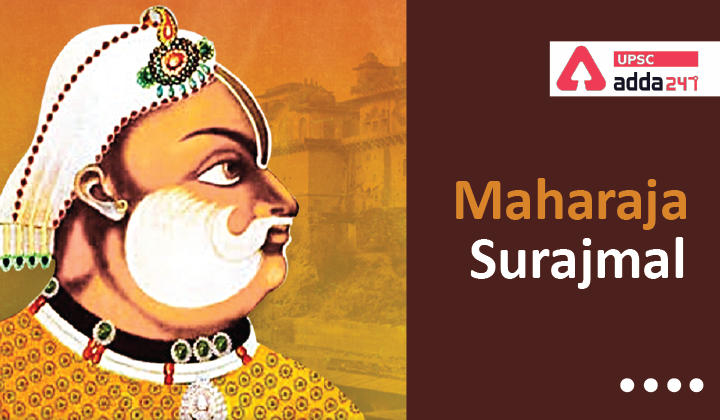Table of Contents
Maharaja Surajmal- Relevance for UPSC Exam
- GS Paper 1: Indian History- Modern Indian history from about the middle of the eighteenth century until the present- significant events, personalities, issues.

Maharaja Surajmal- Context
- Recently, the Prime Minister has paid tributes to Maharaja Surajmal on his birth anniversary (Jayanti).
Maharaja Surajmal– Key Points
- Birth: Maharaja Surajmal was born on 13 February 1707 in the kingdom of Bharatpur, Rajasthan. Maharaja Surajmal ruled in the 18th century and was the son of the Jat chieftain Badan Singh.
- Maharaja Surajmal is often described as “the Plato of the Jat people” and by a modern writer as the “Jat Odysseus”.
- This is because of his political sense, steady intellect and clear vision.
- Beliefs:
- On Religion: Maharaja Surajmal believed that humanity is the only religion of man. He united various factions of Hindus and Muslims and kept them together.
- On Racism: He was against racism and even employed people according to their abilities in higher posts, irrespective of their races.
- On Farmer: Maharaja Surajmal believed that the farmer is the most important part of society. He heard the problems of farmers and introduced reforms to rectify them.
- Death: Suraj Mal died on Sunday 25 December 1763. He died in a battle after being ambushed by the army of Mughal chief Najib-ad-Dawlah.
Raja Ram Mohan Roy- Indian Social Reformer
Maharaja Surajmal- Military Adventures
- In the Princely State of Jaipur: After the death of Maharaja Jai Singh (a friend of Surajmal), his two sons- Ishwari Singh and Madho Singh fought for the throne of the Jaipur.
- In this fight, Surajmal Supported elder son Ishwari Singh got victorious. But the battle did not end here.
- Later, Madho Singh returned to the battlefield with the Marathas, Rathores, and Sisodia Kings of Udaipur.
- But Surajmal with his 10000 army men arrived in support of Ishwari Singh and defeated the Madho singh’s army and he got the royal text of Jaipur.
- After this battle, the dunk of Maharaja Surajmal started ringing all over India.
- With Nawab of Delhi: In 1750, he defeated the Mughal Army of Salabat Khan and forced the latter to accept all his terms.
- In support of Safdar Jung, he plundered the old Delhi during the civil war among the Mughals.
- Extension of Jurisdiction: In 1753, Maharaja Surajmal extended his jurisdiction to Delhi and Feroz Shah Kotla.
- Conflict with Marathas: Above extension of Jurisdiction angered Ghaziuddin, who instigated the Maratha chieftains against Surajmal.
- Marathas attacked Bharatpur and surrounded the fort of Kumher for several months. But this did not end with anyone’s victory rather Marathas made a treaty with Surajmal.
- Impenetrable Lohagarh Fort: It was built by the Maharaja Surajmal and even after attacking 13 times, Britishers could not penetrate it.
- Third Battle of Panipat: Maharaja Surajmal played a key role in the 3rd Battle of Panipat 1761 in which Marathas lost to the invading armies of Afghan general Ahmed Shah Abdali.




 TSPSC Group 1 Question Paper 2024, Downl...
TSPSC Group 1 Question Paper 2024, Downl...
 TSPSC Group 1 Answer key 2024 Out, Downl...
TSPSC Group 1 Answer key 2024 Out, Downl...
 UPSC Prelims 2024 Question Paper, Downlo...
UPSC Prelims 2024 Question Paper, Downlo...




